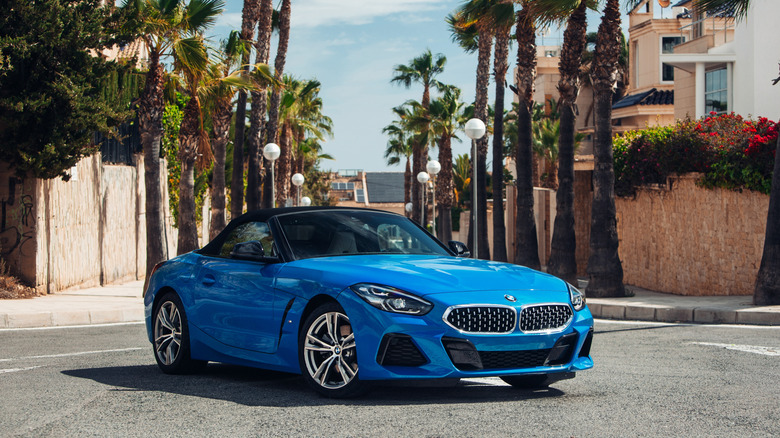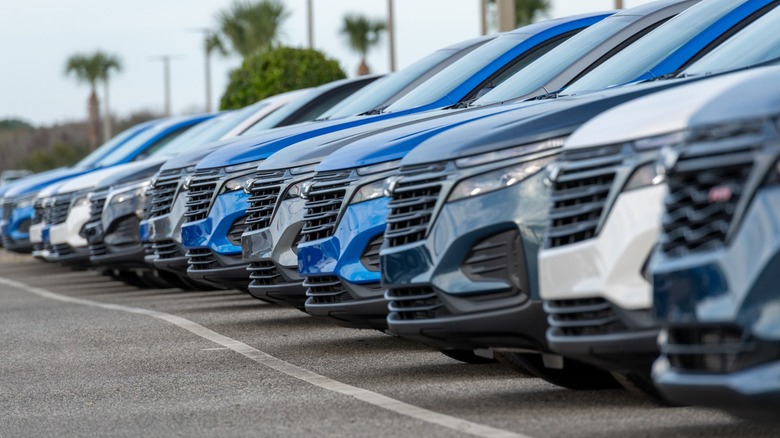The Surprising Reason You'll Want To Avoid Buying A Blue Car
Some car shoppers may pretend like it doesn't, but what color your vehicle is matters. Its color affects how people perceive it, and ultimately influences how much money they're willing to buy it for. In short, a car's color plays a part in its value. If it didn't, car companies wouldn't sell certain colors for a higher cost, like Tesla does with its Model 3. This fact also means that color might aggravate or cushion the rate of a car's depreciation, and if you're looking to maximize resale value when shopping for a vehicle, then you'll also have to be strategic when choosing its color.
A 2024 iSeeCars analysis of over 20 million cars sold in the U.S. (model years 2004-2023) from January 2023 to April 2024 revealed that blue cars are the fifth most common cars purchased, accounting for 8.9% of the total distribution in that sales window, after white (27.6%), black (22.0%), gray (21.3%), and silver (9.1%). Blue did, however, finish ahead of red and over half a dozen other colors.
NexusMedia conducted a study of the 10 best-selling car models to determine which color among five of the most common (blue, black, red, silver, and white) depreciates the most, and blue had the highest rate, with 27.11% over the first five years of ownership — which worked out to an average lost value of over $12,000.
There are nuances to the blue car depreciation studies you should be aware of
NexusMedia's findings and another iSeeCars analysis of the best and worst car colors for resale value seem to slightly contradict each other, and that's because of how they each conducted their research. While iSeeCars' 2025 study looked at the entire used car market, analyzing over 1 million three-year-old cars in different colors, NexusMedia only looked at the 10 best-selling models, and just five mainstream colors. In iSeeCars' breakdown, gold and some beiges are the worst for resale, while blue ends up around average — in fact, it actually does well in the coupe and convertible segments. NexusMedia also compares MSRP vs. current asking prices over five years, while iSeeCars uses broad market data to determine how much each color has depreciated
When you balance these findings with each other, you'll discover that blue is more "unstable" than "terrible." However, while it may look perfectly average on the whole U.S. market, that volatility is what should worry you as a value-conscious buyer.
Other important financial facts about blue cars
Among the various things NexusMedia's study proves, one of the most interesting is how badly the value of EV cars drops. EVs could save you money in the long run, but according to the data, one of the worst depreciating cars is a blue electric vehicle, which can easily depreciate over 50% in just five years. The difference is quite drastic, too, because, while the blue Tesla Model Y lost 50.4% of its value, red Teslas lost 3.2%, and white Teslas lost only 0.8%.
Another interesting fact is that in 2019, iSeeCars discovered that blue cars were most likely to be discounted heavily in the used luxury market. Ly from iSeeCars said, "Deals on blue cars are commonly found on luxury vehicles such as the BMW 7 Series, Mercedes-Benz E-Class and Mercedes-Benz GLE, which suggests that luxury buyers prefer colors in grayscale." Depreciation is one thing that makes luxury cars both a good and bad bargain. If you could get it for less simply because the color is blue, then that could be a good deal. On the flip side, it might also lead to higher depreciation if you ever want to sell it off.


